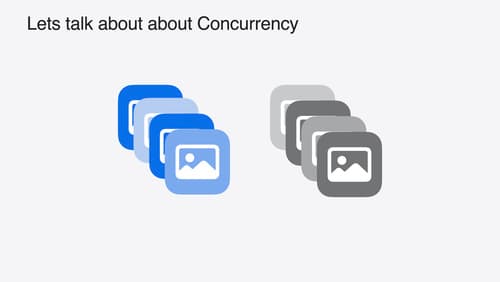how do I run tasks in the background
Asked on 2024-08-03
1 search
To run tasks in the background in Swift, you can utilize Swift's concurrency features, specifically using async and await keywords, as well as task groups. Here are some relevant points from the WWDC sessions:
-
Using Task Groups:
- In the session Explore the Swift on Server ecosystem, it is demonstrated how to run multiple tasks concurrently using a task group. You can create a discarding task group and add child tasks to run different parts of your application concurrently.
-
Concurrency with Async/Await:
- The session A Swift Tour: Explore Swift’s features and design explains how Swift uses the
asyncandawaitsyntax to handle asynchronous operations. When a task is waiting for an asynchronous operation to complete, it suspends to yield the CPU to other tasks.
- The session A Swift Tour: Explore Swift’s features and design explains how Swift uses the
-
Limiting Concurrent Tasks:
- In the session Discover Swift enhancements in the Vision framework, it is shown how to limit the number of concurrent tasks to manage resources effectively. For example, you can limit the number of tasks to five to ensure that no more than five requests are processed at a time.
-
Background Operations with Actors:
- The session Migrate your app to Swift 6 discusses how adopting Swift concurrency can help organize background operations using dedicated actors, making the concurrency architecture more clear and manageable.
By leveraging these concurrency features, you can efficiently run tasks in the background in your Swift applications.

Explore Swift performance
Discover how Swift balances abstraction and performance. Learn what elements of performance to consider and how the Swift optimizer affects them. Explore the different features of Swift and how they’re implemented to further understand the tradeoffs available that can impact performance.

Discover Swift enhancements in the Vision framework
The Vision Framework API has been redesigned to leverage modern Swift features like concurrency, making it easier and faster to integrate a wide array of Vision algorithms into your app. We’ll tour the updated API and share sample code, along with best practices, to help you get the benefits of this framework with less coding effort. We’ll also demonstrate two new features: image aesthetics and holistic body pose.

A Swift Tour: Explore Swift’s features and design
Learn the essential features and design philosophy of the Swift programming language. We’ll explore how to model data, handle errors, use protocols, write concurrent code, and more while building up a Swift package that has a library, an HTTP server, and a command line client. Whether you’re just beginning your Swift journey or have been with us from the start, this talk will help you get the most out of the language.
